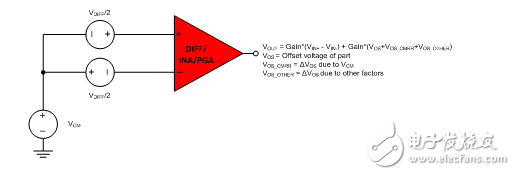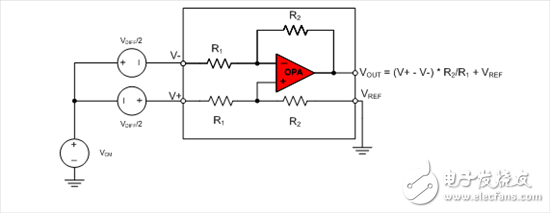CMRR influencing factors based on operational amplifiers
If you are an op amp, you may never have thought about accepting an instrumentation amplifier (INA). This is because INA is more powerful and performs better in critical applications such as current sensing and sensor signal conditioning. INA also does not need much external assistance, they will not open the ring. However, they are not versatile and often more expensive than op amps, so don't give up hope.
A key function of the INA is to adjust small differential signals in the presence of large common-mode voltages and DC potentials. The INA is designed to reject common mode voltage (VCM) and only gain or adjust differential voltage (VDIFF). The error passed to the output through the common mode voltage is determined by the Common Mode Rejection Ratio (CMRR) specification. Figure 1 defines the common-mode voltage of the INA and shows the reference input error voltage that can be caused by changing the common-mode voltage.

Figure 1: Representation of the common mode voltage of INA
The INA is an inherently derived product of a differential or subtractor amplifier with a high impedance buffer on the input. So when we talk about INA, it's best to start with a differential amplifier. As shown in Figure 2, the differential amplifier should only amplify the differential mode signal and reject the common mode signal. This is true for an ideal amplifier with a perfectly balanced resistor. Practical applications must consider not only the common-mode rejection of the amplifier, but also the error that does not match the resistance.

Figure 2: Differential Amplifier
Resistance matching is very important. In the above figure, the matching of R2 and R1 is the main factor of the CMRR of the differential amplifier. The table below shows the potential worst case CMRR for differential amplifiers with different tolerance resistors. Laser trimming of monolithic differential amplifiers and INAs, such as the INA149 and INA826, achieves greater than 0.01% matching.
For a normal 3 op amp INA like INA128 (see Figure 3), the input amplifier also contributes to the CMRR, but the resistor matching on the output stage differential amplifier usually dominates the specification. In addition to the high impedance input, it is also possible to gain differential signals in the first stage and reduce the effects of CMRR errors.
Figure 3: Three-Operation INA and its voltage nodes
So now we know what effect CMRR has?
CMRR is important in applications where you are trying to modulate small differential signals present at large common-mode voltages or in noisy environments where there is general noise on each terminal (such as 50/60 Hz power line noise). If you do not select a part for your application, a CMRR error may affect your measurement results. Example applications include current sensing or sensor signal conditioning (see Figure 3).
Figure 4: Application example
The CMRR will also vary with the frequency of the INA, similar to an op amp.
Elevator Advertising Projector
Elevator projector, elevator projection, elevator projector advertising,Smart Elevator projector,elevator advertising projector,lift advertising Projector,Interactive Projection
Guangdong Elieken Electronic Technology Co.,Ltd. , https://www.elieken.com